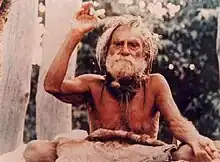Devraha Baba
Devraha Baba (died 19 June 1990), was an Indian Siddha Yogi saint who lived beside the Yamuna river in Mathura. He was known as "ageless Yogi".
Devraha Baba | |
|---|---|
 Deoraha Baba's | |
| Personal | |
| Born | Not Known (but rumored to be around 250 years ago) Deoria, India |
| Died | 19 June
1990 [1] Vrindavan, Uttar Pradesh |
| Resting place | Vrindavan, Uttar Pradesh |
| Religion | Hindu |
| Nationality | indian |
| Temple | Kuti Mandir Ram janki marg(Basti), Sugriv Qila (Ayodhya) |
| Senior posting | |
| Based in | India |
| Successor | Sri Purushottamacharyaji, Devdasji (Bade Sarkar), Devraha Hans Baba |
Life
Little is known about the early life of Devraha Baba, beyond that in the first half of the 20th century he visited Maiel, a town 20 km south west of Salempur, Uttar Pradesh. Here he started living atop a machan, a high platform made of wooden logs, situated 3 km from the town on the banks of Sarayu river. The place was near chilma Bazar Deoria District, thus local people started calling him Devraha Baba, with Baba being an honorific for saints or old men. Thereafter he shifted to Vrindavan, where again he lived atop a machan on the banks of Yamuna river for the rest of his years.[2][3] He visited many places in India and known in different names in different states. At Purneswari Maa Tara Tarini shakti Peetha in Ganjam (Odisha), locals addressed him by the name of Chamatkari Baba. Even today, the priests of Maa Tara Tarini Shakti Peetha remember his miracles during his visit to Maa's Peetha. Once Devraha Baba also attested to it in an Interview with All India Radio.
Devraha Baba was a hermit from Vrindavan.[4] He was considered to be a "spiritual guide to everyone from a pauper to the most powerful ... above narrow confines of caste and community."[5] Village people as well as important personalities waited for hours to have a glimpse or darshan of him.[6] He received visits from politicians seeking his blessings at the time of general elections, including Indira Gandhi, Buta Singh,[6] and Rajiv Gandhi.[7] Rajiv Gandhi and his wife Sonia Gandhi visited his ashram on the eve of the 1989 elections.[8] He used to bless the devotees with his feet.[9]
He lived on a 12-foot-high (3.7 m) wooden platform near the river and wore a small deerskin.[10] A barricade of wooden planks hid his semi-naked body from his devotees, and he came down only to bathe in the river.[11]
Notes
- "Baba in the report who makes Congress squirm". The Indian Express. 8 December 2009. Retrieved 20 December 2012.
- "Personalities: Devraha Baba". Retrieved 10 May 2014.
- Cohen (2000), p. 284.
- Jaffrelot, Christophe (2010). Religion, caste, and politics in India. New Delhi: Primus Books. p. 240. ISBN 9789380607047.
- "Devraha Baba's indictment enrages seers in Ayodhya". The Times of India. 2 December 2009. Archived from the original on 5 May 2013. Retrieved 18 December 2012.
- Cohen (2000), pp. 283–285.
- Dasgupta, Swapan (11 December 2009). "Beyond the Old Books – Modern India and the discourse of faith". The Telegraph (Calcutta). Archived from the original on 15 December 2009. Retrieved 19 December 2012.
- Kidwai, Rasheed (2003). Sonia, a biography. New Delhi: Penguin Books India. p. 131. ISBN 9780670049554.
- Jaffrelot, Christophe (2012). Copeman, Jacob; Ikegame, Aya (eds.). The Guru in South Asia: New Interdisciplinary Perspectives. New York and Oxon: Routledge. p. 83. ISBN 9781136298066.
- Tully, Mark (2004). Moraes, Dom (ed.). The Penguin Book of Indian Journeys. New Delhi: Penguin India. pp. 101–105. ISBN 978-0141007649.
- Crossette, Barbara (22 November 1989). "India to Begin Voting; Today on Fate of the Nation and the House of Nehru". The New York Times.
References
- Cohen, Lawrence (2000). No Aging in India: Alzheimer's, The Bad Family, and Other Modern Things (2000 ed.). University of California Press. ISBN 0-520-22462-0. - Total pages: 367
- Lutgendorf, Philip (2007). Hanuman's tale: the messages of a divine monkey (2007 ed.). Oxford University Press. ISBN 978-0-19-530921-8. - Total pages: 434
- Rama, Swami (1978). Living with the Himalayan masters: spiritual experiences of Swami Rama (1978 ed.). Himalayan International Institute of Yoga Sciences & Philosophy. - Total pages: 490